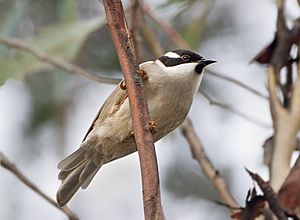Strong-billed honeyeater facts for kids
Quick facts for kids Strong-billed honeyeater |
|
|---|---|
 |
|
| Conservation status | |
| Scientific classification | |
| Genus: |
Melithreptus
|
| Species: |
validirostris
|
| Synonyms | |
|
Eidopsarus bicinctus Swainson |
|
The strong-billed honeyeater (Melithreptus validirostris) is a type of bird that belongs to the honeyeater family called Meliphagidae. It is special because it is found only in Tasmania, an island state of Australia. This means it is endemic to Tasmania. It lives in cool, temperate forests.
Contents
About the Strong-billed Honeyeater
What Does It Look Like?
The strong-billed honeyeater is a medium-sized bird, about 16.5 to 17.5 centimeters (6.5 to 7 inches) long. Its back is olive-brown, and its belly is light grey-brown. It has a black head, neck, and throat. Around its eye, there's a pale blue or off-white patch. You can also spot a white crescent shape on the back of its neck.
Young strong-billed honeyeaters look a bit different. They have brownish crowns and a lemon-colored patch on their neck. The base of their beak is orange. When this bird calls, it makes a loud cheep cheep sound or a churring noise.
Where Does It Live?
This honeyeater prefers to live in old, mature forests with very tall trees. These trees often include types of Eucalyptus like Eucalyptus regnans and E. delegatensis.
What Does It Eat?
The strong-billed honeyeater mainly eats insects and other small creatures without backbones. It finds these by searching on tree trunks. Sometimes, it also eats nectar from flowers and fallen fruit. Even though both the strong-billed honeyeater and the black-headed honeyeater live in Tasmania, they usually don't look for food in the same places.
Family Tree of the Strong-billed Honeyeater
Who Discovered This Bird?
The strong-billed honeyeater was first officially described by a bird expert named John Gould in 1837. The scientific name for this bird, validirostris, comes from two Latin words: validus, meaning 'strong', and rostrum, meaning 'bill'. This name perfectly describes its strong beak!
Its Place in the Bird World
This bird is part of a group of honeyeaters called Melithreptus. Most birds in this group are similar in size and have black heads, except for the brown-headed honeyeater.
Scientists have studied the DNA of these birds. They found that the strong-billed honeyeater separated from the common ancestor of the brown-headed and black-chinned honeyeaters a very long time ago, between 3.4 and 6.7 million years ago.
Another bird that is a relative, but much larger, is the blue-faced honeyeater. More recently, DNA studies have shown that honeyeaters are related to other Australian bird families. These include the pardalotes, the Acanthizidae (like Australian warblers and thornbills), and the Maluridae (like Australian fairy-wrens). All these families are part of a larger group called Meliphagoidea.
Reproduction and Life Cycle
Strong-billed honeyeaters usually build their nests and lay eggs between September and January. They might breed once or twice during this period.
Their nest is shaped like a deep bowl, made from grasses and pieces of tree bark. They usually build it in the fork of a tall tree, often a eucalyptus. The female bird lays two or three eggs. These eggs are about 22 by 17 millimeters in size. They are shiny, a buff-pink color, and have a few red-brown spots.
Images for kids
See also
 In Spanish: Mielero picudo para niños
In Spanish: Mielero picudo para niños



